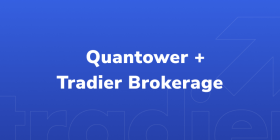Synthetic Instrument. How to create custom spreads in Quantower?

Navigation
Trading in financial markets, the traders face high asset volatility every day, which can bring good profits, on the one hand, and on the other hand - a high risk. Therefore, the risk reduction is one of the most important tasks, which are solved in several ways - by capital management or the implementation of market-neutral strategies. Today, we will consider such strategies that relate to the spread trading.
In the Quantower platform, we have implemented a functionality that allows you to create any non-standard instruments or spreads that you can both trade and use as an indicator of the current market situation or market divergences. This functionality is called Synthetic Instruments.
First of all, let's see what spread trading is and what types of spreads are there.
Spread trading is a strategy that simultaneously creates a long and short position for different assets, in order to reduce the risk of the entire portfolio. Each side of the spread is called a "Leg", which is necessary to set the weighting factor for, i.e. the number of contracts for buy or sell. A market-neutral position, which does not depend on whether the market will go up or down is obtained with a proper selection of these coefficients.
The most popular types of spreads include:
- Exchange or broker arbitrage
- Commodity or futures spreads
- Pairs trading
- Index or Portfolio arbitrage
How to Create a Custom Spread in Quantower?
For example, let's build a spread between different brokers within the same asset and see if there is a difference in prices. This is a classic example of Broker arbitrage.
- Open the Synthetic Instruments panel and click "Create Synthetic".
- Set the name for your spread and select a trading instrument.
- Click "Add Leg" to add another instrument. You can add an unlimited number of instruments by creating new "legs"
- Set the coefficients for each leg. In our example, we buy 1 lot of EUR/USD from the LMAX broker and sell 1 lot of EUR/USD from the OANDA broker.
- Click the "Save" button to calculate the received spread.
- Open the Chart panel and select your spread from the list of instruments.
It can be seen from the chart that there is an arbitrage in prices between the two brokers, but the practical implementation of this strategy should be checked more carefully. By the way, this type of trading is one of the most popular among hedge funds, especially in new or emerging markets (for example, Crypto-Exchange Arbitrage).
Commodity or Futures Spreads
Another popular spread-trading strategy is commodity spreads, which can be standardized by the exchange or created artificially. Such spreads can be traded as a difference in prices between different delivery times of one instrument, or different types of instruments.
For instance, you can build a commodity spread between Soybeans and Wheat or a spread between two oil types Brent and Light Oil. Trading such spreads come down the analysis of seasonal fluctuations, which are associated with production cycles of these assets.
Pairs Trading
The strategy of the pair trading allows you to trade a market-neutral portfolio of assets with a relatively minimal risk. But for the creation of a "pair", it is necessary to take into account not only the high correlation coefficient between the two assets but also to select trade coefficients. That is, in simple terms, necessary to correctly assess the position volume for each side of the spread.
The description of the basic principles of creating a paired spread and the correct choice of the coefficients will be considered in the following articles.
Index or Portfolio Arbitrage
If the pair trading strategy includes a couple of currencies or stocks, the index arbitrage involves creating a spread of several instruments. A simple example of an index is the ETF, which can consist of, let's say, 100 stocks with the different weight coefficients calculated based on the stock price, capitalization, market share, etc. In other words, the total change in stock prices will lead to a change in the value of the index, but uneven. Those securities that make up a large percentage of the index weight, for example, 10%, will affect the index significantly stronger than others, with stocks close to 1%.
So what is the arbitration? Each ETF is considered an issuer company, which recounts its value based on the current stock prices included in this index. But if your ETF pricing model is different from the one used by the issuer, then you can have a trading advantage. This strategy is often used by hedge funds that have a direct connection to exchanges, and receive trading quotes a little faster than the other market participants.
Whatever strategy of spread trading you have chosen, be sure to learn all the subtleties of trading tools to exclude the occurrence of any pitfalls.





Comments